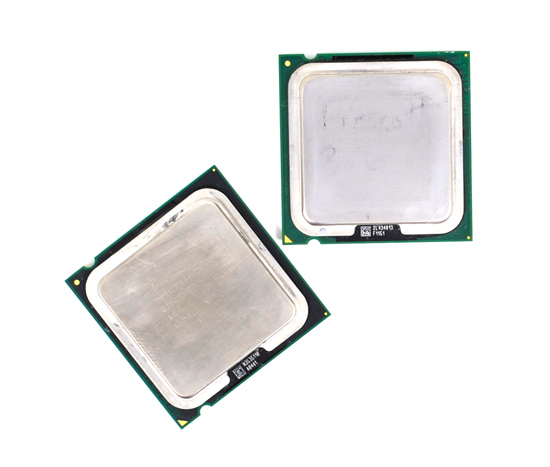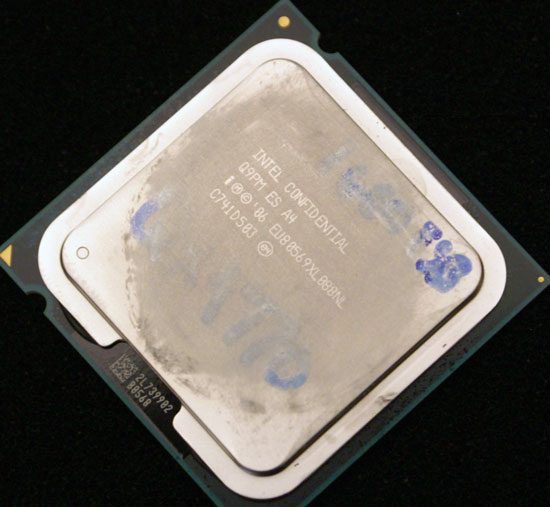The Core i7 980X Review: Intel's First 6-Core Desktop CPU
by Anand Lal Shimpi on March 11, 2010 12:00 AM EST- Posted in
- CPUs
Extreme Edition: 2010 vs. 2008 vs. 2005
Last year I dusted off two CPUs from 2005 and included them in Bench - the Pentium 4 660 and Pentium Extreme Edition 955. You can still compare any modern CPU to those chips in Bench, but to show how far we've come I've included the Pentium Extreme Edition 955 in today's review.

Pentium Extreme Edition 955 (left) and Pentium 4 660 (right)
When it was brand new, the 3.46GHz Pentium EE 955 cost $999. Five years later, it gets to go up against its namesake carrying the same price tag.
I've also included the Core 2 Extreme QX9770, the fastest Core 2 Quad processor that was ever sold:

In 2008 the 3.2GHz chip sold for over $1000 and remains the only desktop Intel CPU to require a 1600MHz FSB. It was indeed the last of a dying breed.
| Motherboard: | ASUS P7H57DV- EVO (Intel H57) Intel DP55KG (Intel P55) Intel DX58SO (Intel X58) Intel DX48BT2 (Intel X48) Gigabyte GA-MA790FX-UD5P (AMD 790FX) |
| Chipset Drivers: | Intel 9.1.1.1015 (Intel) AMD Catalyst 8.12 |
| Hard Disk: | Intel X25-M SSD (80GB) |
| Memory: | Corsair DDR3-1333 4 x 1GB (7-7-7-20) Corsair DDR3-1333 2 x 2GB (7-7-7-20) |
| Video Card: | eVGA GeForce GTX 280 (Vista 64) ATI Radeon HD 5870 (Windows 7) |
| Video Drivers: | ATI Catalyst 9.12 (Windows 7) NVIDIA ForceWare 180.43 (Vista64) NVIDIA ForceWare 178.24 (Vista32) |
| Desktop Resolution: | 1920 x 1200 |
| OS: | Windows Vista Ultimate 32-bit (for SYSMark) Windows Vista Ultimate 64-bit Windows 7 x64 |










102 Comments
View All Comments
cactusdog - Thursday, March 11, 2010 - link
This wont be the only i7 6 core desktop CPU. Intel are being sneaky to milk the market. There will be another one or possibly 2 at mainstream prices. The cheapest Xeon gulftown is only $400 (2.26Ghz) so why would Intel ignore desktop when X58 boards will happily run a Xeon?GourdFreeMan - Thursday, March 11, 2010 - link
That strategy could just as well backfire on Intel. If you have to wait six months for the other hexacore desktop Gulftowns, you might as well forgo Gulftown entirely and wait a year to fifteen months for hexa/octocore Sandy Bridge. The new AVX instructions in Sandy Bridge are likely to have a far broader impact on performance in terms of software anyway...Triple Omega - Thursday, March 11, 2010 - link
Well I hope you're right. As right now it looks like even Sandy Bridge releasing at least 26 months after the 920 will still have only 4 cores maximum. Not much of a replacement.Also, did anyone notice they broke their own Moore's-Law rule? The 980X only has 1,6 times the transistors of it's predecessor.
DrMrLordX - Friday, March 12, 2010 - link
As I posted above:http://en.wikipedia.org/wiki/List_of_future_Intel_...">http://en.wikipedia.org/wiki/List_of_fu...rocessor...
JumpingJack - Thursday, March 11, 2010 - link
"Also, did anyone notice they broke their own Moore's-Law rule? The 980X only has 1,6 times the transistors of it's predecessor. "You have a fundamental misunderstanding of Moore's Law, this is not unexpected because it is often misquoted or misrepresented in the less technically oriented press. The proper way to state Moore's law is the transistor count will double roughly every two years for the same die size, or for the same transistor count the die size will half. Yet the best way is to simply say the transistor density (transistor/unit area) will double.
You can check the 32 nm adherence to Moore's law by following up on the technical presentations that float around the web, Intel published their IEDM 2009 32 nm stuff:
Also, did anyone notice they broke their own Moore's-Law rule? The 980X only has 1,6 times the transistors of it's predecessor.
http://download.intel.com/technology/architecture-...">http://download.intel.com/technology/ar...-silicon...
See the scaling for gate pitch or SRAM cell size slides 5 and 6, they are clearly falling right on the Moore's law path.
This is not by accident, a linear scaling factor of 0.7 when squared is 0.49 or roughly 0.5 i.e. half the area, this factor is chosen to get double the transistor density each technology node.
talonz - Thursday, March 11, 2010 - link
"Moore's Law" refers to density, not actual transistor count. Anyone can build a big chip.tterremmotto - Thursday, March 11, 2010 - link
Actually, Moore's law has nothing to do with density nor speed. It was about price.Moore's "observation" simply stated that the price per transistor halves every 18 moths. Wether that is due to density increases or process advancement is not a necessity.
Never an observation has been so misunderstood, and yet have such a fantastic side effect.
JKflipflop98 - Thursday, March 11, 2010 - link
Actually, Moore's law is all about transistor density. I know. I see it everyday in the halls, in the elevator, at my desk, in the cleanroom. . .JumpingJack - Thursday, March 11, 2010 - link
He has a small point, Moores Law is just an obseravtion of the rate of shrinkage over time, the phenomena is driven by the economy of scale.Jack
softdrinkviking - Thursday, March 11, 2010 - link
where are you getting your xeon pricing info from?all i can find from any solid source is the current xeon quad core processors which are running about $2000 on newegg at the moment.
xeons have always carried a premium for the intel dual processor support, and imho, a cheaper xeon is going to be more "enterprise" oriented and not be a real upgrade for the home x58 platform.
again, this is pure speculation, but i think we are going to be stuck with our current i7 stuff until intel decides to do a 32 nm refresh on the home line up.
basically, what i'm trying to say is that i think any xeon capable of creaming an i7 930 is going to be WAY more expensive than the 980x gulftown on display here.